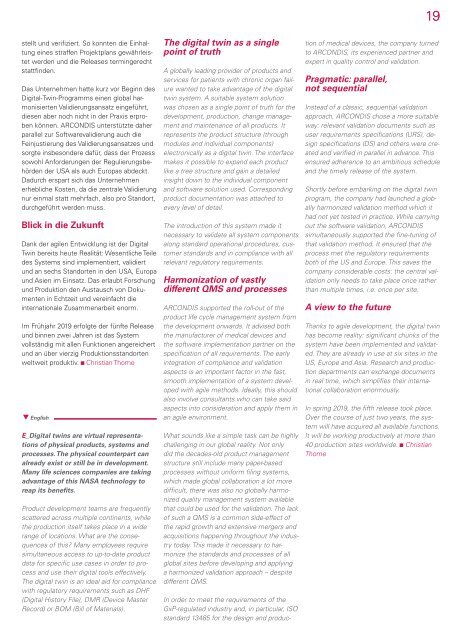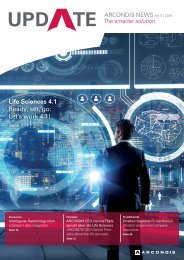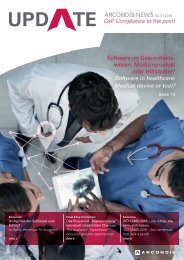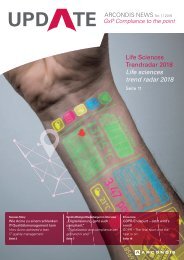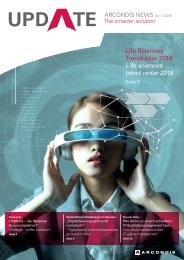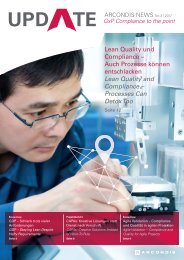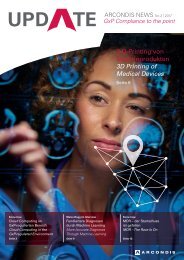ARCONDIS UPDATE No. 02|2019: The smarter solution
ARCONDIS Kundennewsletter für die Themenbereiche Business Applications und Compliance in Life Sciences Unternehmen
ARCONDIS Kundennewsletter für die Themenbereiche Business Applications und Compliance in Life Sciences Unternehmen
Create successful ePaper yourself
Turn your PDF publications into a flip-book with our unique Google optimized e-Paper software.
19<br />
stellt und verifiziert. So konnten die Einhaltung<br />
eines straffen Projektplans gewährleistet<br />
werden und die Releases termingerecht<br />
stattfinden.<br />
Das Unternehmen hatte kurz vor Beginn des<br />
DigitalTwinProgramms einen global harmonisierten<br />
Validierungsansatz eingeführt,<br />
diesen aber noch nicht in der Praxis erproben<br />
können. <strong>ARCONDIS</strong> unterstützte daher<br />
parallel zur Softwarevalidierung auch die<br />
Feinjustierung des Validierungsansatzes und<br />
sorgte insbesondere dafür, dass der Prozess<br />
sowohl Anforderungen der Regulierungsbehörden<br />
der USA als auch Europas abdeckt.<br />
Dadurch erspart sich das Unternehmen<br />
erhebliche Kosten, da die zentrale Validierung<br />
nur einmal statt mehrfach, also pro Standort,<br />
durchgeführt werden muss.<br />
Blick in die Zukunft<br />
Dank der agilen Entwicklung ist der Digital<br />
Twin bereits heute Realität: Wesentliche Teile<br />
des Systems sind implementiert, validiert<br />
und an sechs Standorten in den USA, Europa<br />
und Asien im Einsatz. Das erlaubt Forschung<br />
und Produktion den Austausch von Dokumenten<br />
in Echtzeit und vereinfacht die<br />
internationale Zusammenarbeit enorm.<br />
Im Frühjahr 2019 erfolgte der fünfte Release<br />
und binnen zwei Jahren ist das System<br />
vollständig mit allen Funktionen angereichert<br />
und an über vierzig Produktionsstandorten<br />
weltweit produktiv. Christian Thome<br />
English<br />
E_Digital twins are virtual representations<br />
of physical products, systems and<br />
processes. <strong>The</strong> physical counterpart can<br />
already exist or still be in development.<br />
Many life sciences companies are taking<br />
advantage of this NASA technology to<br />
reap its benefits.<br />
Product development teams are frequently<br />
scattered across multiple continents, while<br />
the production itself takes place in a wide<br />
range of locations. What are the consequences<br />
of this? Many employees require<br />
simultaneous access to up-to-date product<br />
data for specific use cases in order to process<br />
and use their digital tools effectively.<br />
<strong>The</strong> digital twin is an ideal aid for compliance<br />
with regulatory requirements such as DHF<br />
(Digital History File), DMR (Device Master<br />
Record) or BOM (Bill of Materials).<br />
<strong>The</strong> digital twin as a single<br />
point of truth<br />
A globally leading provider of products and<br />
services for patients with chronic organ failure<br />
wanted to take advantage of the digital<br />
twin system. A suitable system <strong>solution</strong><br />
was chosen as a single point of truth for the<br />
development, production, change management<br />
and maintenance of all products. It<br />
represents the product structure (through<br />
modules and individual components)<br />
electronically as a digital twin. <strong>The</strong> interface<br />
makes it possible to expand each product<br />
like a tree structure and gain a detailed<br />
insight down to the individual component<br />
and software <strong>solution</strong> used. Corresponding<br />
product documentation was attached to<br />
every level of detail.<br />
<strong>The</strong> introduction of this system made it<br />
necessary to validate all system components<br />
along standard operational procedures, customer<br />
standards and in compliance with all<br />
relevant regulatory requirements.<br />
Harmonization of vastly<br />
different QMS and processes<br />
<strong>ARCONDIS</strong> supported the roll-out of the<br />
product life cycle management system from<br />
the development onwards. It advised both<br />
the manufacturer of medical devices and<br />
the software implementation partner on the<br />
specification of all requirements. <strong>The</strong> early<br />
integration of compliance and validation<br />
aspects is an important factor in the fast,<br />
smooth implementation of a system developed<br />
with agile methods. Ideally, this should<br />
also involve consultants who can take said<br />
aspects into consideration and apply them in<br />
an agile environment.<br />
What sounds like a simple task can be highly<br />
challenging in our global reality. <strong>No</strong>t only<br />
did the decades-old product management<br />
structure still include many paper-based<br />
processes without uniform filing systems,<br />
which made global collaboration a lot more<br />
difficult, there was also no globally harmonized<br />
quality management system available<br />
that could be used for the validation. <strong>The</strong> lack<br />
of such a QMS is a common side-effect of<br />
the rapid growth and extensive mergers and<br />
acquisitions happening throughout the industry<br />
today. This made it necessary to harmonize<br />
the standards and processes of all<br />
global sites before developing and applying<br />
a harmonized validation approach – despite<br />
different QMS.<br />
In order to meet the requirements of the<br />
GxP-regulated industry and, in particular, ISO<br />
standard 13485 for the design and production<br />
of medical devices, the company turned<br />
to <strong>ARCONDIS</strong>, its experienced partner and<br />
expert in quality control and validation.<br />
Pragmatic: parallel,<br />
not sequential<br />
Instead of a classic, sequential validation<br />
approach, <strong>ARCONDIS</strong> chose a more suitable<br />
way: relevant validation documents such as<br />
user requirements specifications (URS), design<br />
specifications (DS) and others were created<br />
and verified in parallel in advance. This<br />
ensured adherence to an ambitious schedule<br />
and the timely release of the system.<br />
Shortly before embarking on the digital twin<br />
program, the company had launched a globally<br />
harmonized validation method which it<br />
had not yet tested in practice. While carrying<br />
out the software validation, <strong>ARCONDIS</strong><br />
simultaneously supported the fine-tuning of<br />
that validation method. It ensured that the<br />
process met the regulatory requirements<br />
both of the US and Europe. This saves the<br />
company considerable costs: the central validation<br />
only needs to take place once rather<br />
than multiple times, i.e. once per site.<br />
A view to the future<br />
Thanks to agile development, the digital twin<br />
has become reality: significant chunks of the<br />
system have been implemented and validated.<br />
<strong>The</strong>y are already in use at six sites in the<br />
US, Europe and Asia. Research and production<br />
departments can exchange documents<br />
in real time, which simplifies their international<br />
collaboration enormously.<br />
In spring 2019, the fifth release took place.<br />
Over the course of just two years, the system<br />
will have acquired all available functions.<br />
It will be working productively at more than<br />
40 production sites worldwide. Christian<br />
Thome


